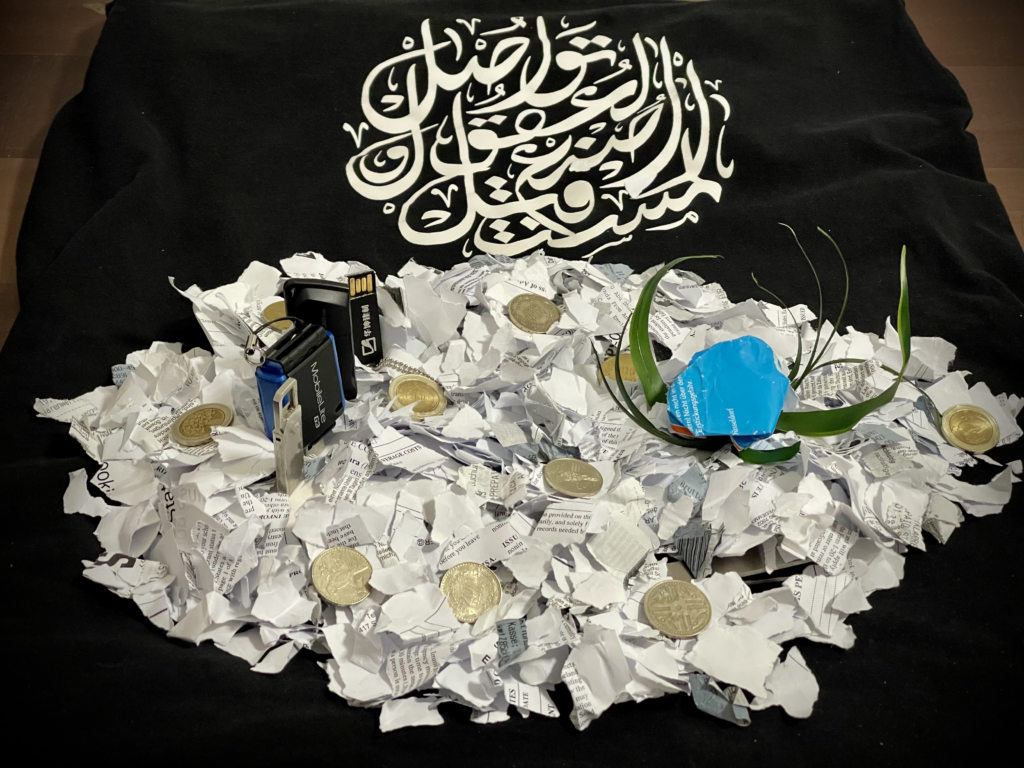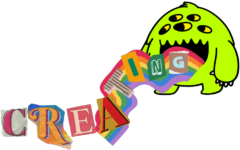- Field.io is a very inclusive creating environment that engages all its members as a community. They are R&D based and their start point for creation is play or experimentation. Their medium is computer graphics with a focus on physical simulation
- Physical simulation can either visualize / generate feelings for abstract topics or extract abstract topics from a concrete object. In other words, it is like finding an visual anchor that can slightly guide the audiences’ imagination on the concept. The former aspect can be exemplified by the IBM project, while the latter one can be exemplified by the Quantum Computing project.
- Their projects can be also used to intensify a feeling that people feels in some environment. The key is to capture elements that condenses the vibe of the environment. Examples include the London and Beijing Adidas project
- One of the creators are inspired by narratives instead of previous CG examples because this provides freedom to create something unique. However, the other one thinks that the narratives alone are too flat.
Author: Oscar Wang
Making Assignment 4 – NYU Intercampus Portals
When I was thinking about physical borders yesterday, one topic that came into my mind was our very university: NYU, which is set across borders — strictly speaking, 15 of them. To connect all of them, why don’t we erect a portal at each campus? I am tired of flying on intercontinental flights ten times a year😉.

This drawing of the portal was made by Canva. I used a model of the iconic Washington Square Arch as the main structure. The departure times were also chosen in a way assuming that portal crossing is instantaneous. The users would not end up at their destination during early morning or late night.
In addition, there has always been a superstition (though not true) that someone walking under the Washington Square Arch would fail courses and not graduate. In this way however it also prevents anybody to walk literally “under” it 😹.
By the way, the portal site at NYU Abu Dhabi, as you can see from the picture, is located at the construction site at the west of our campus. Since I don’t really know what project is currently going on there, so why not let it be a portal?
Class Visit Response 1 – Robert Seidel
These are the notes that I took during and after the talk:
- He uses random drawings to clear the mind before a project.
- Exploring lights and colors, merging his understanding as a biology student (evolution, decay, rebirth, and growth) into his creation.
- Find the personal pathway with any available tech, not being restricted by their conventional uses.
- Enjoying what I am doing now as we’re not constrained by deadline, budget and industry.
- Hybrid Films – non-traditional form of presentation. Integrating films with multiple media other than screens. Ideas not restricted by scale. e.g. LED on Buildings / walls, projections…
- Merging with Reality. e.g. natural history museum – film includes abstract elements from fossils, plant, animals….
- Audience is much more intelligent than you think. Just tell the story in your way, stay true to it. It can translate to others.
- Work in contrasting locations open new inspirations.
- Museums are collection and condensation spots of human knowledge. Easily resonate and create abstract representation of ideas.
- Projection Sculptures – creation of both projection and objects. Need both to work. Revitalize old structures, like adding soul to them
- Hysteresis – Covid, Feeling Torn, Feeling Tension Use AI to fuse renaissance style into dancer movements. AI is trained to be good at recognizing patterns (e.g. recognizing muscles – renaissance style) actively that regular filters can never do.
- Openness to interpretation of audience ideas may help, but the backbone should still be yours.
They are very useful for me as I can really resonate with and admire his work. I would love to create a piece that engages everybody, remain in their minds unconsciously, and closely related to the local environment. Especially after visiting the Großer Wasserspeicher, I really would like to aim for a project that utilizes the whole space with sound and light that people can interact with. It would be best if it can connect to the complex history and symmetric, circular topography of the place that gives echos.
Making Assignment 3 – Rethinking Borders
In this assignment, I have to consider a topic and question its original intuitive logic through the lateral purpose of “why”. The intention of this kind of “why” is to create discomfort with any explanation or established assumptions through vertical thinking. The result of this chain of why’s should be counterintuitive from the starting logic.
When I was returning to the dorm passing through the Gedenkstätte Berliner Mauer, this topic suddenly flashed into my mind:
Physical Borders
- Why do countries have physical borders? To completely separate different kinds of people and control their flow.
- Why do they want to completely separate them? They want to control the mixing and interaction between people.
- Why do they want to control this? Because different countries have different laws and regulations.
- Why they have different laws and regulations? Because their societies are formed with different cultures, social norms, ideologies, values, and histories.
- Why is different cultures, social norms and stuff a problem? Because these are difficult to change which make people put barriers without thinking but just assuming the negative effects of difference.
- Why do people tends to avoid the negative effects of difference? Because firstly-perceived differences are often superficial and stereotypical. They just represents tendencies.
- Why are firstly-perceived differences superficial and stereotypical? Because direct interaction between the two sides are limited.
At this level of questioning, since the two sides of such physical borders are usually limited in interactions, which gives rise to a vicious circle pointing back to points 5 and 6, instead of creating a drastic line separating the two, why don’t we create a wide area of conversation, tolerance, and exhibition between the two while still maintaining some control? We can see the effects of the lateral purpose of “why” here. We started from physical borders but went down to human interaction. Moreover The facilitating nature of this structure is counterintuitive from the separation nature of traditional physical borders people would assume.Using BrickLink studio, a virtual LEGO designing software that can produce real-looking images, I can render my idea generally using this LEGO model.
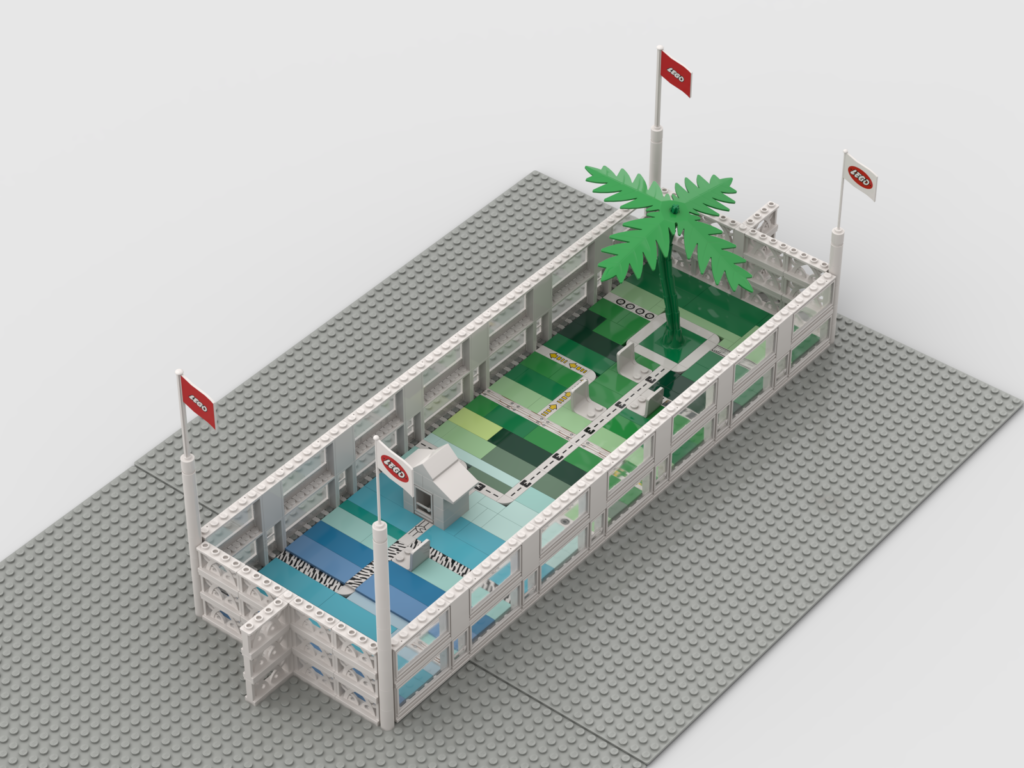
The gradually mixing color of the tiles symbolizes the communication between the two. The red and white LEGO flags are used to represent country flags. The walls are made of glass and glass doors are placed densely, providing easy means of seeing through and passing the border. I used trees, houses and chairs to symbolize the facilities that can be established in between this space. Between the walls, people of either sides can engage in recreational activities, relaxing, commerce, reading, concerts, public events, speeches, sports and so much more…Especially events that are both competing and uniting like sports, an inspiration I got from the border volleyball between US and Mexico border residents.
I wish that someday in the future, when the gigantic metal and concrete cage walls between countries that are interested in establishing these jarring structures all come down, the world can unite and celebrate its diversity under the leaves, roofs, and cheer of these redesigned borders, and all of us can play volleyball with our friends on the other side, across the long-gone walls replaced by only markings or volleyball nets just like what the Berlin Wall is now.
Reading Response 3 – Purpose of Lateral Thinking
In this chapter, the author explored the reasons behind the need for lateral thinking and also pointed out why creativity, humor and insight cannot be easily trained. He first mentioned the self-coding / pattern making and self-organizing nature of our mind and then used the resulting jelly model of our memory surface to visualize our brains’ processing of new information. We have a tendency to fit them to existing patterns. Humor and Insights, however, are basically restructuring the patterns. However, they are sudden and cannot be predicted. For my personal experiences, the sense of humor comes to me like an electric shock when I see something that I can make humor on. This points to his description of the inherent disadvantages of this system caused by the great advantages of it which makes us tend toward using and relying on it. Lateral thinking can tackle especially three of them: it can help escaping cliche patterns, remixing information into ideas, and restructuring. The use of random stimulation can be effective on our self maximizing memory surface as it creates new patterns actively. Disruption and provocation can help dividing and diverging existing patterns.
Reading Response 2 – Lateral Thinking
Creativity has been long regarded as a special talent, a result-driven perspective that people “without this talent” is difficult to grasp on. This book introduces the notion of lateral thinking, a mode of gathering and processing information closely related to creativity that anyone can learn to gain using his or her insight. This book describes lateral thinking as restructuring, escape and the provocation of new patterns, which I see related to one of our classmate’s thought on creativity as “remixing existing ideas”.
Lateral Thinking is complementary to traditional, or vertical / logical thinking used in math and logic. Lateral thinking is generative and vertical thinking is selective. Hence, I believe that one should master both in order to be creative. Moreover, vertical thinking is dealing with the middle steps between the starting choice and the conclusion. It is sound and strong, but cannot extend beyond the constraints of the initial perceptual choice. It questions the initial assumptions and prevents the arrogance of any seemingly rigid conclusion. Lateral thinking is like digging a hole at a different place. For me, it is like as if we are useing different probation techniques to understand the full properties of some new material.
Making Assignment 2 – Erinnerungsland / Land of Memories
This assignment extends on the topic of the last one through the concept of creative lateral thinking. I first came up with five alternative concepts / meanings that are related to desert and then several things I can make from one of the five alternatives. The results are shown below.
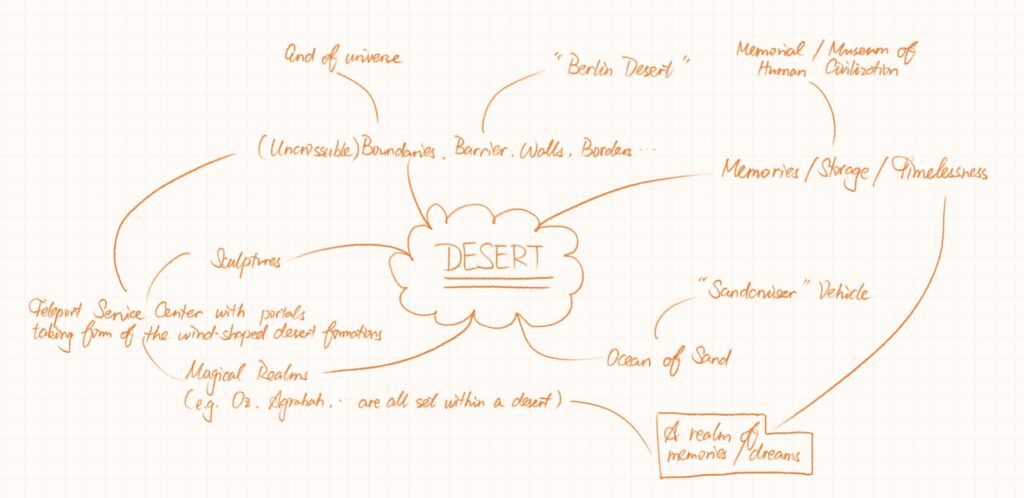
Suddenly, the concepts of memories and magical realms lighted a spark in my mind. Even as an electrical engineering student, I have always been intrigued in psychological concepts, whose discipline investigating the brain, the closest thing that we cannot fully understand but utilize through instinct. Hence, memories, or other brain functions, can be having a sort of “magic-like” property under current understanding of neuroscience. I have also been actively collecting and sorting memories through photos, videos and social media posts to make them ready and able to be reviewed and relived anytime I want. Every piece of wonderful memory to me should be treasured, like gems in the desert of all information that I gathered through my brain. Moreover, I have been interested in and making transit maps for a long time so why don’t I merge these two together to create a map of my personal mystical realm beyond the furthest reach of the vast desert of consciousness?
Hence, I called my work the “Land of Memories” or “Erinnerungsland” in German. From my very own perspective and cultural and linguistic background, it is also interesting how the fusional nature of German word formation makes the word sounds like a place that exists somewhere in fiction. However, this realm is not consisted of actual detailedly grained memories but that feeling I escape to every time I feel frustrated. The general images / feeling of the memories that someone think of them a long time after they have experienced it are what remains to be long-term in mind, and they are usually the most positive / negative things you felt at that moment (of course for this work only positive ones are considered). It also included idealistic or fictional elements that I believe to be harmonic and connected with other real-world memories. This place should be an embodiment what I feel to be idealistic and perfect, and nourishes, fosters, and reboots my tired mind after frustration. Since the feelings are already abstract, I decided to put icons to represent memories instead of other literal elements. These icons
Using Canvas, a software that contains innumerable vector image resources, I can make this map. First, I took a sandy background to symbolize the immense desert of consciousness. Colorful sands are then added to different clusters corresponding to different kinds of valuable memories. Places and symbols are added by hand to give this map an antique and mystic vibe. The stars marks the places I wanted to be teleported to most whenever stuck in the corresponding feeling.

Explanation of the names:
- Mirs Bay – My hometown of Shenzhen, a coastal town with alternative name “Mirs City”, contains golden memories of my family, core of everything.
- Litchia – Rendered name of my elementary school, contains childhood memories.
- Jungfrau – Jungfraujoch, Switzerland. A Childhood Trip that inspires me to care for Mother Nature. Contains relaxing memories spent with everything naturally created around us.
- The Grid – My natural inclination towards systematic disciplines such as physics, chemistry, and engineering and my memories of seeing the beauty within the numbers and formulas.
- Stella – Changsha, a bustling town in Central China that is always in party mood and never sleeps, a place where I had my middle and high school educations, made a lot of friends there.
- Camellia Hill – Name of the place where my high school sits, contains good memories of me studying, competing, and preparing for applying our dream schools with my friends.
- Gazelle Island – Obviously Abu Dhabi. Contains memories about how I transcended myself when being in such an international and accepting environment in the past years, as well as the meaningful conversations I had with my friends.
- Grapevale – A trip to the Caucasus (Georgia and Armenia) last year, sparkled my interest in world travel and made two of my best friends in collage.
- New Territories – Memories being made and yet to come…
The stars marks the portals that connects to places, symbolizing bad feelings.
- Swirl of Nostalgia – Missing Home
- Forest of No Return – Too obligated / concerned
- Concrete Cage – Lost in the Modern Cities
- Infinite Maze – Purposelessness
- Some Island – Loneliness
- Coward’s Pass – Defeated
- Foggy Jungle – Pessimistic
- Pond of Clouds – Melancholic
- Timeless Town – Stuck in the Past
The direction indicator points towards “H”, meaning Home or Heart.
If made interactively, this may also be a good way for people to sort memories. Possible implementation: use AI to analyze and categorize gallery input and generate new “territories” and symbols as user record more of his or her life. The icons acts as an access point to the AI-synthesized video of that part of memory.
Studio Visit Response 1 – Markus Popp
I found most of Markus Popp’s point resonating to me. First, I also believe that seeing the big picture in every way is important for everyone to not loose track in his or her life. Having a goal can justify one’s question about the purpose of life and not involving too much, meaning solely involving in his or her career path and point of interest, can make him or her a full person. Seeing the big picture also means being an observer. When standing in a third-party perspective, I can see the development and trend of a field in a more comprehensive way. I took this class for similar reasons as an engineering student. For me, I would love to engage in work such as research and product development engineer but not as a pure researcher or task-oriented engineer as I want to engage in actual solutions that can make people’s life better step by step. Engaging in creative activities can let me think outside the box and see new things in new perspectives that a normal task-oriented engineer would never see. I like to see my contributions adds their effects to the world as a whole. Second, I reckon that developing the previously said “big-picture” way of thinking can help add your touch to the field you are interested in. For example, his familiarity with perfumes and scent can aid his music composition and “signs” his albums with tangible themes uniquely to him such as scents, romance, etc. Third, he also emphasized the importance of punchline thinking, triumph moments, and moments that surprises yourself. These can reassure you that you are on the track you original envisioned to accomplish when feeling too dragged by necessary technicalities and details (e.g. Marcus uses these to mediate his music making process when being drawn to sit at a laptop for 16 hours due to the detailed work of using the music software).
However, I was initially a little baffled and now partially disagree with his drastic distinction between the artist and content creator. To me, although people, in terms of their goals, may aim more towards answering to his or her own instincts or to create content when asked by others, everyone should be the mix of the two. They complement and develop on each other. For example, some content creators may find it useful to add his or her personal touch to a content creating process and some artists are also creating content for this world to some extent in order to live. They may also share the same goal but work towards it in different ways. I also partially disagree on his current position on avoiding the AI until there exists an established effect of AI on the creation of music. Although I believes that using AI purely may let the artist tend to use it for the whole creation process, losing the small propulsion and sense of achievements from the regular triumphant moments as well has the creator’s soul, uniqueness and aim for perfection, completely avoiding AI is not a good practice. AI can be an aid for lateral thinking, it is like having an friend that has perspective and thinking process completely different from anyone you can find (obviously because they are wired completely differently from any human). Using AI for hints and brainstorming or gathering inspiration can actually be quite helpful in my opinion.
Reading Response 1 – Kermit
Kermit the Frog started by mentioning an issue that has been bothering a large number of people: the “meaning” of life. I am obviously one of them when I was young. However, I later on justified myself with his point. The answer lies in creativity, which will make the world a better place for others because of your existence and achievement. Kermit believes that creativity is not a small group of people’s ability or right to do so. I also strongly reckon his point as I believe that the notion of creativity is “spontaneity into any process” and is inherent in all people. It is not restricted to artists but also scientists and researchers coming up with a new field of interest, engineers that makes a new design decision or invention, even common people who puts his or her own touch to interior design, dinner and so much more. Kermit believes that creativity moves the society forward, and is inherent in the definition of human intelligence.
He emphasized that to gain creativity, one should open his or her arms to acceptable failures and risks or what he called “controllable chaos”. Hence, one should be ridiculously optimistic about trying different things. This also resonated with me. I have always believed that there are more than one way to solve a problem as all problems are interconnected. One solution may provide a better way to solve this particular problem, while others may solve the problem in acceptable efficiency but also benefits the solution of other problems.
I also resonated deeply with his idea of a “Beginner’s Mind”, meaning that being interested in exploring new things like a child would do. It is not acceptable or even scary for me to consider losing interest to and rejecting new ideas or things that can contribute to the solution of the issue. For me, this even applies for serious manufacturing such as planes as mentioned in the talk. For these kind of problem, if a better solution is thoroughly tested and proven to be much more efficient then the existing one, than there is no need to stick to the old solution anymore. I wish that this notion of a “beginner’s mind” can be more acknowledged in the future, becoming a skill not only for kids but for anyone who is actively participating in making the world a better place.
To better hone my creativity skills, I should value Kermit’s next point on teamwork. While I am always open and respect new ideas, perspectives or pathways and recognizing their uses in understanding the full picture of the solution of a problem, teamwork was usually not a preference for me. I now realized the power of active collaboration and will start to recognize the importance of balancing my views and solution with actively searching for teams and new solution when dealing with new problems.
Overall, this was a very informative, resonating and fun talk. I rethought my notion on creativity during all parts of the talk and refreshed them through thinking about Kermit’s viewpoints.
Make Assignment 1 – Desert
“Desert”, a word in English that has the same spelling with the word meaning “abandoned” and referring to a type of barren landscape, seems to be a tricky topic choice for this creating assignment. Hence, the first step that I took was to write down just the word “desert” and record whatever comes to my mind. When I looked at that word and closed my minds, I soon reminisced from my mind the experiences when I was with my friends under the starry sky of the Abu Dhabi deserts; and from that, I connected other memories and thoughts I had when I was in the UAE.
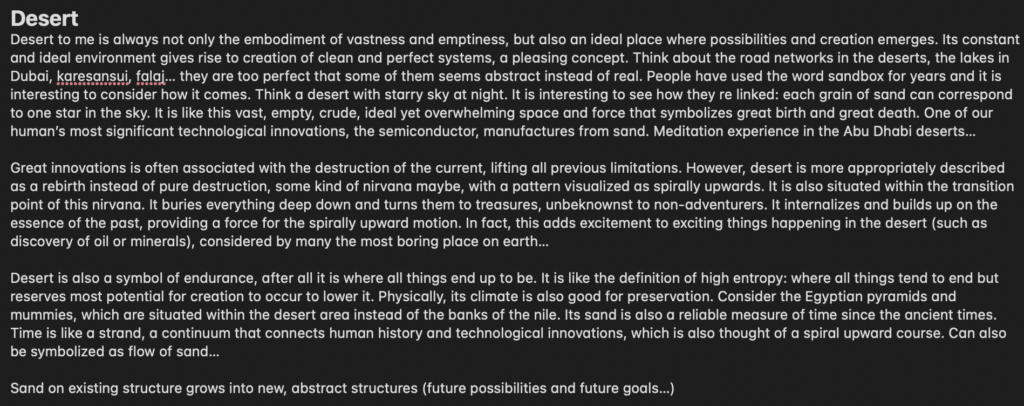
The results seem rather far-reaching. However, they provided me with many thoughts and insights about the notion of “desert”, both physical and metaphorical. In order for me to implement easily, I hence decided to make a small desert out of old newspapers to symbolize the desert’s timelessness and relation to ancient means of timekeeping through sand. Next, I decided to add oasis and coins to symbolize the deserts’ nature of a place of possibilities, hidden treasures, and in a broader sense, creation, just like the word “sandbox”.
The first step of this work is to create a base for the “sand” to sit on. The base also let the sand to have a wavy trend like sand dunes.However, it is quite difficult to find newspaper nowadays so old wastepaper with words are used instead.
The u-disks inserted into the “sand” symbolizes technological advancements. For example, they can be interpreted as buildings (whose concrete requires sand), or civil engineering-related fields. We can also look at it from a material or electrical point of view (also related to the use of sand). The flash and ICs in the disks are mainly made from silicon while the quartz is obviously made from quartz. Both of which are derived from silicon dioxide, which can be basically regarded as sand with higher purity. I found this interpretation quite interesting.
The oasis are made from blue packaging and actual plant leaves. This symbolizes the intrinsic and eternal element of hope in each and every desert. We can also say from the use of actual leaves and packaging that as our society progress in this constant spiral of destruction and creation just like how desert buries everything that comes before it into a crude state and turns them into essence for the next cycle of creation, what advances is not just technology or wealth, but also respect for and integration with our gorgeous and perfect nature around us.
The background was inspired when I look into my clothes through a mirror. This shirt was from Expo 2020 Dubai with its main theme “Connecting Minds, Creating Future” printed in calligraphy of Arabic, a language spoken in the vast deserts. This line further stresses the desert’s contribution in creation and unseen possibilities in advancements for a higher common cause.
